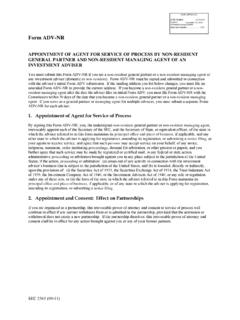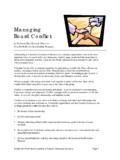Transcription of Managing Conflict: A Guide for Volunteer Boards
1 Managing Conflict: A Guide for Volunteer Boards Participating as a member of a board of directors of a non-profit or voluntary organization is one of the most important roles we can play in a democracy. Indeed, many people feel that a vibrant democracy requires engaged citizenship; that electing government representatives and obeying the law, as important as these are, is not enough to make our communities work. Volunteer Boards offer an intimate experience for participating in public life. They call upon our intellect and our hearts as well as our skills. People bring to any important conversation a wide range of experiences and perspectives. Wherever individuals with strong convictions work together there will be differences; how we engage and manage those differences determines whether such conflict will get in the way of our collective wisdom, or, enable it to emerge.
2 Conflict can be constructive. Managed well it promotes change and adaptation, awareness of self and others. It can even strengthen relationships and heighten morale. Managed poorly however, conflict can also be destructive. Its ability to hurt individuals and damage relationships is what affects us most because, despite our effort to tell ourselves not to, we take it personally. Conflict, whether out in the open or submerged, is one of the leading reasons for board member and executive director resignations. Community organizations and their Boards of directors can be fertile ground for conflict because they tend to be: Diverse in their membership Involve passionate, caring people Struggle with being unified and focused in terms of mission and goals in the face of many important demands Be an expression of alternative democratic structures and processes: non-authoritarian, non- hierarchical and inclusive.
3 Require shared leadership by a Volunteer board and an executive director. Operate in a dynamic, frequently adversarial, political context What lies behind most conflict? While we are often quick to attribute board strife to a conflict of personalities , most of the differences that we experience are more complex than our individual styles or traits. Friction can certainly result from unhelpful behaviour in terms of interpersonal communication. But conflicts can also result from lack of information, different views of what information is important, or even varying interpretations of available information. Often, conflict is rooted too in different needs or interests and the perception that all the choices facing the organization are in competition with one another. Structural conflicts involving a struggle over power or authority are also common.
4 Value conflicts , the most difficult to resolve, result from different ways of understanding the world; our ideals in the broadest sense. 2006 Non-Profit Sector Leadership Program, Dalhousie University Page 1 Managing Conflict: A Guide for Volunteer Boards The Emotional Dimension of Conflict Emotions are always present where issues and relationships are at stake. The idea that we can leave them outside the meeting, is false. It is the emotional dimension of conflict that is the most difficult factor for most of us to deal. In Resolving conflicts at Work, Kenneth Cloke and Joan Goldsmith point out that: Our emotions can be constructive or destructive, pleasurable or painful, positive or negative. They can distort or clarify our communication, escalate or de-escalate our conflicts , encourage us to act collaboratively or prevent us from doing so.
5 They can blind us or allow us to see others as they truly are. They can leave us exhausted or fulfilled. ( ) Conflict is not a battle between the rational and irrational. The presence of strong emotions means that people care; that the issues and the relationships, often both, are close to people s hearts. For every negative emotion there is a positive one; what we are against reminds us what we are for. Cloke and Goldsmith remind us: When we withdraw from our emotions, we end up learning little or nothing about what gave rise to them, or how to experience them fully, or how to respond to them skillfully, or how to recognize what lies underneath them. When we relax, we let go of our fear of expressing emotions, and engage them, we release ourselves from their grip and increase our clarity, creativity, opportunities for learning, and chances for resolution, transformation and healing.
6 ( ) Our emotions inevitably affect important conversations, they seep into our language, or worse, they explode into it. Managing the emotional dimension of conflict has little to do with discussing our feelings and everything to do with acknowledging what is important. Acknowledgement of our feelings our hopes and fears, and an invitation to others to acknowledge theirs, can only humanize the conversation. Four Areas of Conflict 1. Conflict among board members Conflict on the board can arise from differences between or among individual directors or factions of directors. The chair of the board can be a contributing factor when board members are fighting. Indeed the chairperson may be source of the conflict by virtue of running the show or dominating board discussions. He/she may also be the problem because there is no leadership when others are at odds.
7 The chair and executive director can both play a role in resolving board conflict, but the latter is in a very awkward position to act without appearing to take sides or be manipulating the situation. Beyond providing factual information or providing process advice, the executive director is wise to let the chair play the lead role. 2. Conflict between board and executive director Differences between the board and the executive director are probably the most common area of conflict in non-profit organizations. Often these differences will be structural in nature, that is, they have to do with the boundaries of each other s roles and responsibilities. Trust is a huge factor in the board-executive director relationship. The more involved a board is in overseeing operational decisions, even when such oversight is invited by the executive director, the less trust will characterize this relationship.
8 In contrast, the more the board is involved in strategic decisions, the greater will be the trust. 2006 Non-Profit Sector Leadership Program, Dalhousie University Page 2 Managing Conflict: A Guide for Volunteer Boards 3. Conflict among staff members Boards frequently get drawn into conflicts among staff or volunteers. Staff conflicts , and conflicts between a staff member and the executive director, are not uncommon and Boards should not be automatically regard them as an indication of a deficiency in the executive director s management skills. Ideally a board will hear about such situations first from the executive director. Sometimes however, someone with a grievance will choose to do an end run around the executive director and appeal directly to the board. The board may need to get involved either to mediate or arbitrate such disputes especially in situations where no policy has been set.
9 Where the conflict is between other staff members, or between volunteers, a board would be wise to stay clear, especially if it wants to affirm the executive director s authority and accountability. 4. Conflict between the organization and its members and stakeholders. Sometimes the legitimacy of the board can itself be challenged by the members or groups that are part of the organization s constituency. Factions amongst the membership can arise whenever a few people become unhappy with how things are being run and believe they or others can do a better job. A Strategy for Confronting Conflict When the board or the organization as a whole is disabled by a conflict it needs to face it head on. conflicts should not be left to simmer in the hope they will go away. Leadership by the board chair or the executive director in pushing for a resolution process is required.
10 In situations where the board chair or and or the executive director are parties in the conflict, an external resource person should be called upon to assist in a mediation role. Confronting a conflict situation almost always can benefit from face-to-face communication amongst the parties involved, either a series of meetings with individuals and/or a group meeting involving all of the parties. An intervention aimed at resolving the disagreement and repairing a damaged relationship, should: Rely on the involvement of a Volunteer , staff person or external facilitator who has the respect of everyone to facilitate the process. This could be a board member. Boards should avoid handing the work over to an existing board committee. Arrange a special meeting or a series of private meetings, not a board meeting. Regular and official board meetings are not the best place to confront a serious conflict even if all members of the board are involved.






